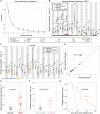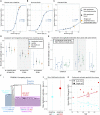cloneRate: fast estimation of single-cell clonal dynamics using coalescent theory
- PMID: 37699006
- PMCID: PMC10534056
- DOI: 10.1093/bioinformatics/btad561
cloneRate: fast estimation of single-cell clonal dynamics using coalescent theory
Abstract
Motivation: While evolutionary approaches to medicine show promise, measuring evolution itself is difficult due to experimental constraints and the dynamic nature of body systems. In cancer evolution, continuous observation of clonal architecture is impossible, and longitudinal samples from multiple timepoints are rare. Increasingly available DNA sequencing datasets at single-cell resolution enable the reconstruction of past evolution using mutational history, allowing for a better understanding of dynamics prior to detectable disease. There is an unmet need for an accurate, fast, and easy-to-use method to quantify clone growth dynamics from these datasets.
Results: We derived methods based on coalescent theory for estimating the net growth rate of clones using either reconstructed phylogenies or the number of shared mutations. We applied and validated our analytical methods for estimating the net growth rate of clones, eliminating the need for complex simulations used in previous methods. When applied to hematopoietic data, we show that our estimates may have broad applications to improve mechanistic understanding and prognostic ability. Compared to clones with a single or unknown driver mutation, clones with multiple drivers have significantly increased growth rates (median 0.94 versus 0.25 per year; P = 1.6×10-6). Further, stratifying patients with a myeloproliferative neoplasm (MPN) by the growth rate of their fittest clone shows that higher growth rates are associated with shorter time to MPN diagnosis (median 13.9 versus 26.4 months; P = 0.0026).
Availability and implementation: We developed a publicly available R package, cloneRate, to implement our methods (Package website: https://bdj34.github.io/cloneRate/). Source code: https://github.com/bdj34/cloneRate/.
© The Author(s) 2023. Published by Oxford University Press.
Conflict of interest statement
None declared.
Figures






Similar articles
-
Can a Liquid Biopsy Detect Circulating Tumor DNA With Low-passage Whole-genome Sequencing in Patients With a Sarcoma? A Pilot Evaluation.Clin Orthop Relat Res. 2025 Jan 1;483(1):39-48. doi: 10.1097/CORR.0000000000003161. Epub 2024 Jun 21. Clin Orthop Relat Res. 2025. PMID: 38905450
-
A rapid and systematic review of the clinical effectiveness and cost-effectiveness of paclitaxel, docetaxel, gemcitabine and vinorelbine in non-small-cell lung cancer.Health Technol Assess. 2001;5(32):1-195. doi: 10.3310/hta5320. Health Technol Assess. 2001. PMID: 12065068
-
Perceptions and experiences of the prevention, detection, and management of postpartum haemorrhage: a qualitative evidence synthesis.Cochrane Database Syst Rev. 2023 Nov 27;11(11):CD013795. doi: 10.1002/14651858.CD013795.pub2. Cochrane Database Syst Rev. 2023. PMID: 38009552 Free PMC article.
-
Does the Presence of Missing Data Affect the Performance of the SORG Machine-learning Algorithm for Patients With Spinal Metastasis? Development of an Internet Application Algorithm.Clin Orthop Relat Res. 2024 Jan 1;482(1):143-157. doi: 10.1097/CORR.0000000000002706. Epub 2023 Jun 12. Clin Orthop Relat Res. 2024. PMID: 37306629 Free PMC article.
-
The effect of sample site and collection procedure on identification of SARS-CoV-2 infection.Cochrane Database Syst Rev. 2024 Dec 16;12(12):CD014780. doi: 10.1002/14651858.CD014780. Cochrane Database Syst Rev. 2024. PMID: 39679851 Free PMC article.
Cited by
-
Single-cell mutational burden distributions in birth-death processes.PLoS Comput Biol. 2025 Jul 7;21(7):e1013241. doi: 10.1371/journal.pcbi.1013241. eCollection 2025 Jul. PLoS Comput Biol. 2025. PMID: 40623094 Free PMC article.
-
Limit theorems for the site frequency spectrum of neutral mutations in an exponentially growing population.Stoch Process Their Appl. 2025 Apr;182:104565. doi: 10.1016/j.spa.2025.104565. Epub 2025 Jan 11. Stoch Process Their Appl. 2025. PMID: 40191782
-
Timing and trajectory of BCR::ABL1-driven chronic myeloid leukaemia.Nature. 2025 Apr;640(8060):982-990. doi: 10.1038/s41586-025-08817-2. Epub 2025 Apr 9. Nature. 2025. PMID: 40205062 Free PMC article.
-
Developmental hematopoietic stem cell variation explains clonal hematopoiesis later in life.Nat Commun. 2024 Nov 26;15(1):10268. doi: 10.1038/s41467-024-54711-2. Nat Commun. 2024. PMID: 39592593 Free PMC article.
References
-
- Antle C, Klimko L, Harkness W. Confidence intervals for the parameters of the logistic distribution. Biometrika 1970;57:397–402.

